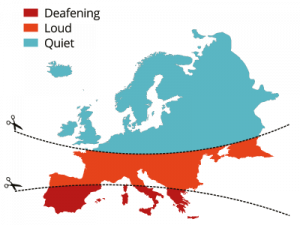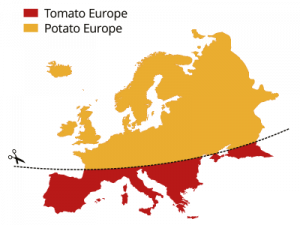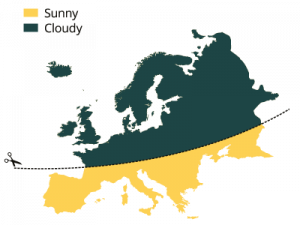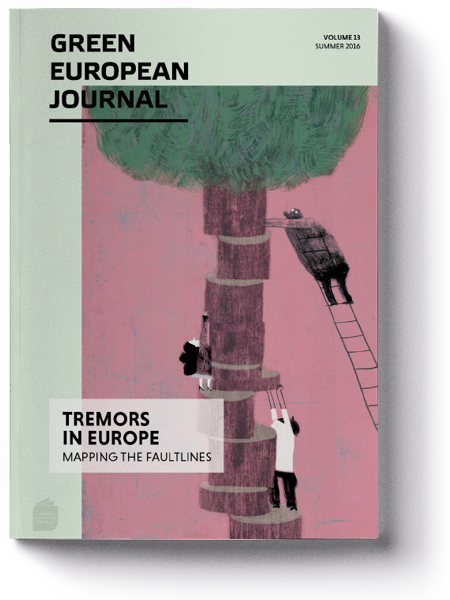Evolutionary psychologist Robin Dunbar, who specialises in studying primate brains, once determined that the amount of human individuals in a functional social group cannot exceed 150. This limit, he argued, is a direct function of relative neocortex size. In other words, we don’t have the physical capacity to maintain a meaningful connection with a larger number of people because there is a shortage of drawers in our brain, where we can store all the necessary gossip. I wonder if this rule applies to political alliances. Is there an optimal amount of countries, after which an organisation becomes dysfunctional?

It’s a tempting question, especially during an economic crisis that has sharpened all kinds of divisions across the European continent. Contemporary politicians speak bout enlargement fatigues, ideological rifts, and the failure of multiculturalism. The older electorate in Europe keeps warm memories of the time when the union was simply a community of a few prosperous countries coexisting in peace, harmony, and perpetual economic bliss.
The decision making in Brussels was light as a breeze, Angela Merkel was still busy sorting out posters for the Free German Youth, David Cameron smoked pot at Eton, and last but not least, the participants in Eurovision were obliged to sing in their native languages. There was a common enemy behind the Iron Curtain, and the threat it constantly emanated made a lot of people, who wouldn’t otherwise be natural allies, unite under a common goal.
And here’s a really naughty question: would there be a European Union if the Soviet one didn’t devour the countries of Eastern Europe one by one? It took just several years after the end of the Second World War to turn the world completely on its head. There were a lot of reinventions of old political ideas, freshly adapted to a bipolar, crudely divided continent.
Stalin, who during the war mastered Realpolitik better than Bismarck, stole the anti-Soviet idea of Georges Clemenceau and hastily started building his own Cordon Sanitaire of small buffer countries that were supposed to protect him from the influence of the pluralist West. He even introduced algebra to politics, trying to persuade his capitalist ally Winston Churchill that foreign political influence in a single country can be divided in percentages among the Great Powers. According to his plan, the United Kingdom was supposed to receive a 90% influence in Greece, 25% in Bulgaria, 10% in Romania, and 50% in Yugoslavia and Hungary. The Soviet Union was supposed to cash in the rest, as if those countries were ingredients in a cooking recipe.
These ridiculous calculations were just a trick to buy more time until the (not so) secret communist agents in the Soviet-occupied territories consolidated their power. Echoing the historic Defenestration of Prague in 1618, which precipitated the Thirty Year’s War, the Czechoslovak foreign minister Jan Masaryk was found dead right below the bathroom window of his office. Stalin had a sense of humour darker than a black hole.

Soon every country where the Soviet percentage was equal to or above 50% suddenly got a 100% communist government, which – to nobody’s surprise – didn’t feel comfortable sharing power with anyone else, rendering all algebraic assurances presented to Churchill meaningless. As a result, Europe received one of its deepest political scars, parts of which were even visible from space at the height of the Cold War.
Lush forest started popping out in the border areas between the enemy states, shaping what is now called the European Green Belt. Many animals, some of which belonging to endangered species, found refuge in those oases. Had the Cold War continued indefinitely, Europe would have gained back its once legendary wild forests, at least in the heavily guarded buffer zones between the two opposing camps.
There was a time when the continent was practically impossible to traverse, and such buffer zones covered vast expanses of land called marches. Geography, nature, and human politics flirted with each other, claiming land back and forth every time two neighboring states started generations-long quarrels. Among the notable examples was the Spanish March, which separated the Franks from the Moors in Iberia. Another one was the territory of modern Denmark, which even kept its original name, meaning March of the Danes.

While a squirrel probably had no problems traveling from Spain to Greece just jumping from branch to branch, for humans moving on dry land was much more challenging. This is why most ancient civilizations in Europe spread along the shores of rivers and seas. The Ancient Romans were the first ones who started building permanent roads in order to keep their provinces connected. Some of those roads remain to this day. The first real cross-continental division of Europe started with the ascent of the Roman Empire. The Romans actually managed to break Europe twice. It began with the divide between the North and the South, or as the Romans understood it, between the wild barbarians and their own superior civilization. The stark cultural disparities between those two worlds started a chain of problems for future European politicians. One of the most notable was between Hitler and his superstitious servant, Himmler, who was busy digging out prehistoric Germanic villages:
“Why do we call the whole world’s attention to the fact that we have no past? It isn’t enough that the Romans were erecting great buildings when our forefathers were still living in mud huts; now Himmler is starting to dig up these villages of mud huts and enthusing over every potsherd and stone axe he finds. All we prove by that is that we were still throwing stone hatchets and crouching around open fires when Greece and Rome had already reached the highest stage of culture.”
The second time the Romans broke Europe was when they divided their own empire in a Western and an Eastern part. What was a purely bureaucratic decision soon spilled over into a cultural and religious rivalry that would continue even to this day in various forms, some of which costing the lives of far too many people…
This text and the cartographics are an excerpt from the chapter “Endless Europe” in the book Atlas of Prejudice by Yanko Tsvetkov.

